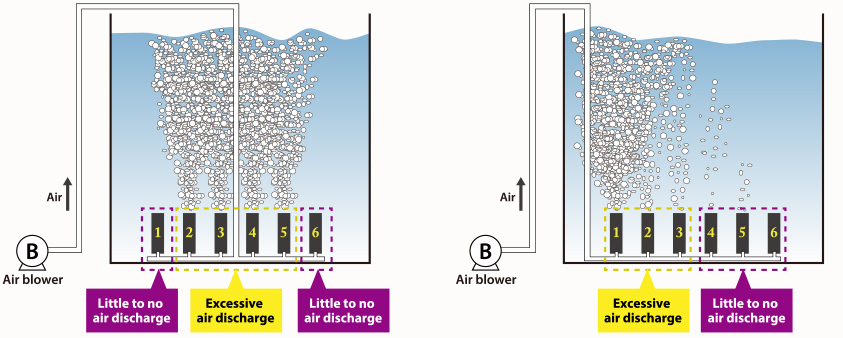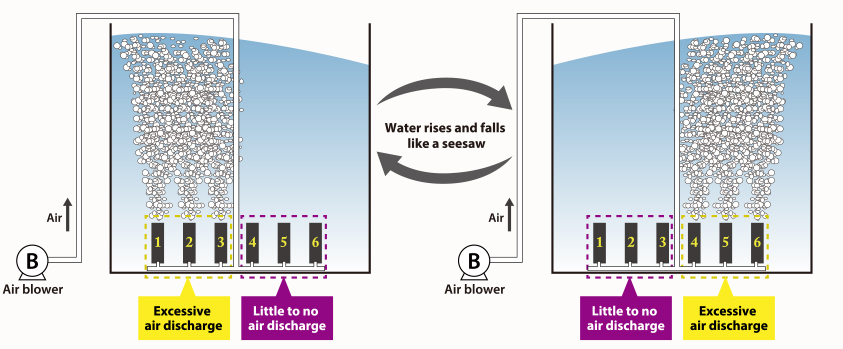Risk of uneven discharge
Feedback from users of imitation OHR AERATORs and similar products
Customers who use imitation OHR AERATORs or similar products often complain that some of the installed diffusers fail to discharge any air, or do so unevenly (see Figure A below). Another common complaint is that air is discharged unevenly in a "seesaw" fashion (Figure B).
The layout on the right has essentially the same issues. The farther the diffuser is from the riser pipe, the less air it discharges.

Immediately after starting the air blower, air discharges from all six units simultaneously. However, it soon begins to alternate between discharging only from the leftmost three units and discharging only from the rightmost three. This uneven airflow causes the surface of the water to undulate in the manner of a seesaw.

Low air discharge resistance increases the risk of uneven air discharge
Air diffusers with a large air discharge opening naturally have very low air discharge resistance. For example, the OHR AERATOR has the lowest air discharge resistance in the world at only 20–30 mmAq (=resistance at a depth of 2–3 cm in water).
Low resistance maximizes air blower performance, which means that large amounts of air can be discharged using little electricity. However, there is a considerable risk of air discharging unevenly when using multiple air diffusers. If this occurs, you will need to carry out extensive pipe reconfiguration. Why does this risk exist in the first place? Observe the following diagram:

- Before the air blower is started, the tank pipes fill with water
- Air from the air blower pushes this water back out
- First, air is discharged from the nearest outlet (in the diagram,
air diffuser No. 1), then from the others in turn
- As the outlets farther from the riser pipe have lower
air pressure, water is unable to be pushed out and
remains in the pipe, hence air is discharged unevenly
- As a result of all of this, the tank is not properly churned in its entirety, allowing anaerobic sludge to accumulate on the bottom
Porous air diffusers can discharge air evenly with simple piping configuration
While the piping configuration for porous air diffusers is straightforward, for air diffusers with a large discharge opening it is more involved and requires complex calculations.
Porous air diffusers discharge air through small perforated pores, which have a high airflow resistance of about 500 mmAq
(=resistance at a depth of 50 cm in water) when brand new. This means that air cannot easily discharge, and it soon fills the entire pipe. Once air pressure has sufficiently built up, air discharges evenly from all of the diffusers at the same time, even if little heed has been paid to the piping configuration.
N.B. Porous air diffusers inevitably clog, further increasing the airflow resistance and decreasing the volume of air discharged. This leads to insufficient oxygen in the aeration tank — a serious issue.
OHR guarantees even air discharge with a bespoke piping configuration
As demonstrated in the first section, care must be taken when designing piping for diffusers with a large air discharge opening such as the OHR AERATOR. Calculations for your particular set of circumstances are essential for even air discharge.
OHR designs an appropriate piping configuration for your particular case and fully guarantees that air is discharged evenly, even when the installed OHR AERATORs number in the hundreds or thousands.












